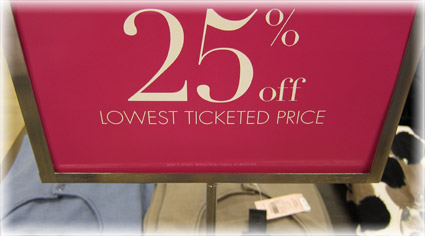Well, another Black Friday has come and gone to cheers within the media. Maybe you yourself picked up a bargain on electronic goods, music or perhaps a fancy shirt. But are Black Friday sales events really a big win for business?
If you listen to the media, YES! But I’m not so sure. I agree that Black Friday contributes billions of dollars ($11.2 billion in 2012) to the retail bottom line. But my question is, at what cost? Retailers shouldn’t be focusing on the total value of sales but whether the gross margin that they receive on their sales makes the whole campaign worthwhile. Because at the end of the day, sellers need to be selling things for a profit rather than just selling things to achieve a revenue target. And looking at some items like solid state drives and other equipment – I’m not sure many sellers are making much money at all.
In order to survive, a business needs to make a profit. Anytime a business discounts goods, they’re making less profit. They’re making less margin and reducing the growth prospects for the business. In this way, discounts should always be used sparingly with sales rather than regularly. My top line view of discounting is that it should only be used to run up old stock which is significantly different from the new stock coming in. Unfortunately many business as revenue targets, which makes it easy to sacrifice profit by slashing away at prices.
Sure, this approach to discounting helps move inventory off the floor to make way for the new inventory. And it can help to attract new customers. But the downside is that it sets a new perceived anchored price point. For example, if I have a stereo system on the floor that I’m trying to sell at my store and its usual retail price is $1,000 and I then discount it to $750. The new perceived price of that stereo category is $750 – for future stereos.
So, if I bring a new stereo into the store with hopes to sell it at $1,000 – it’s going to be an uphill battle. Prospective buyers have seen my previous stereo discounted to $750 have the $750 price point in their mind. This, therefore, makes it very difficult to re-establish your price as the $1,000 stereo. You can avoid this situation by only discounting lines that are being discontinued or far removed from your other business.
So, in summary, don’t use gross revenue as a measure of success. Use gross margin as a measure of your success and only discount on products and services that you are looking to discontinue and that are far removed from your continuing business lines.
Growing your small business,
David Moloney
Small Business Planned
GET FREE INSTANT ACCESS TO THESE
THREE ESSENTIAL SMALL BUSINESS RESOURCES
(To help you maximise your business)

15 Recommended Downloads for Small Business Owners

10 Website Mistakes That Cost You Sales

How to Get More Customers Contacting You Automatically



This is an interesting article! It is true that every time there is a discount for a product it becomes the anchored price point, and consumers will not buy your product for less than the perceived anchored price point, they will just wait until the product is priced at what the consumer think it is worth